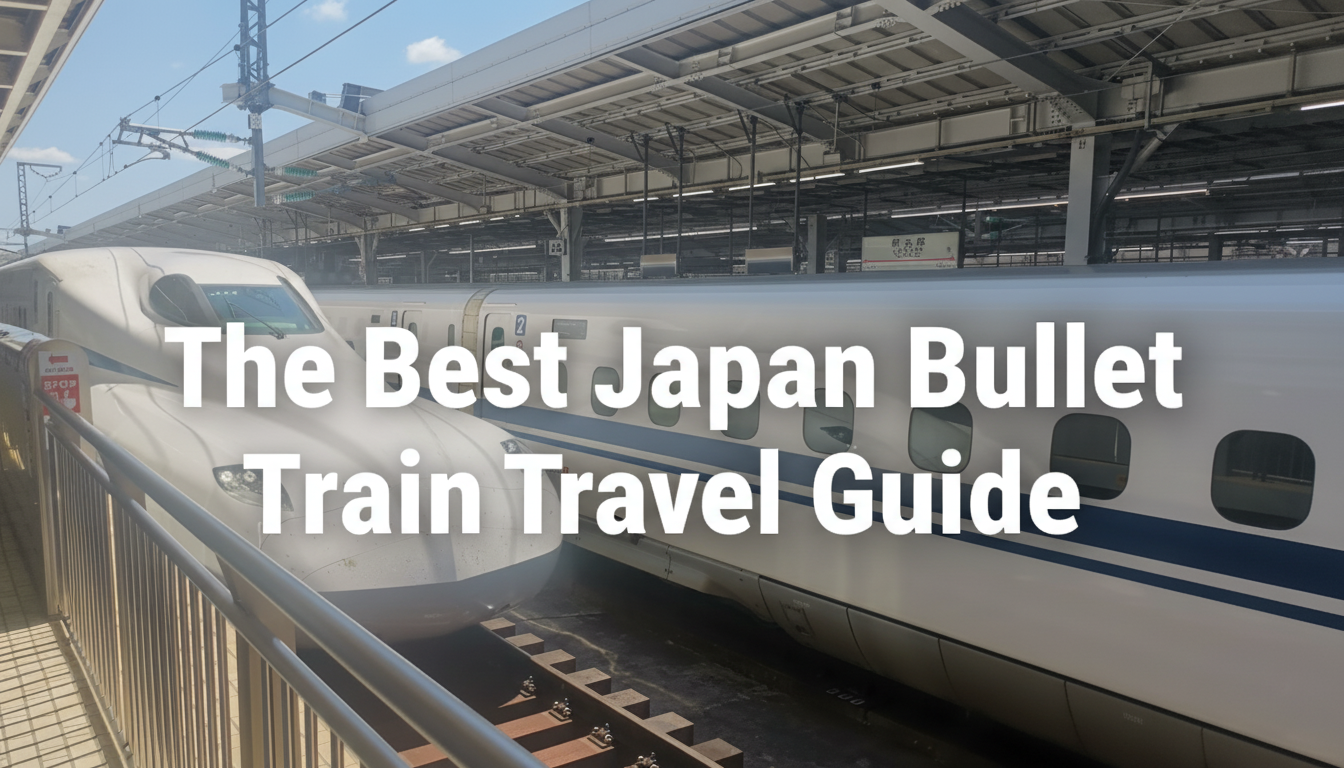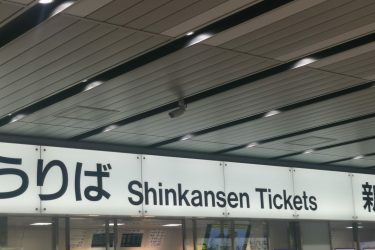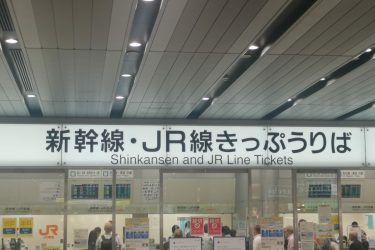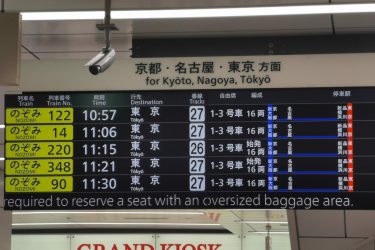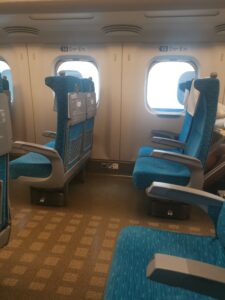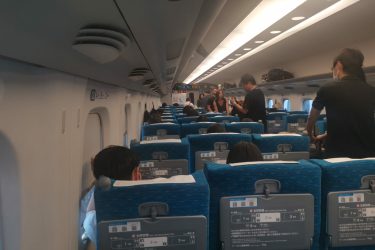One of the most recognizable and effective ways to go throughout Japan is by bullet train, or Shinkansen. The Shinkansen, which is well-known for its comfort, speed, and timeliness, provides a smooth and easy way to travel between major cities and areas.
Efficiency & Speed: The Shinkansen is well known for its amazing speed; certain trains can travel at much to 320 km/h (200 mph). This makes it possible for people to travel large distances in a fraction of the time that they could with alternative forms of transportation. For instance, taking the fastest Shinkansen route cuts the time it would take to get from Tokyo to Osaka—which would take several hours by car—down to just over 2.5 hours.
Punctuality: The Shinkansen’s punctuality is among its most notable features. One of the world’s most dependable modes of transportation is the train, which is known for leaving and arriving on schedule to the minute. When delays do occur, they usually happen by a few seconds. Delays are incredibly rare.
Comfort & Amenities: The Shinkansen is a quick and comfortable way to travel. The trains have roomy seats, lots of legroom, and big windows that let in beautiful views of the rural areas of Japan. There are many service classes available on most trains, such as regular cars, green cars (which are comparable to first class), and on certain lines, luxury cars. Food kiosks with bento boxes, drinks, and snacks are available on board, and Wi-Fi is available on some routes.
Routes of Scenic Beauty: The Shinkansen frequently travels through some of the most breath-taking scenery in Japan. On clear days, the road from Tokyo to Kyoto, for instance, provides vistas of Mount Fuji; alternative routes have seaside landscapes, verdant valleys, and bustling cityscapes. One of the best parts of traveling the Shinkansen is witnessing the changing landscape at a rapid pace.
Usefulness: Even for first-time travelers, navigating the Shinkansen network is simple. The Japan Rail Pass is a well-liked alternative for travelers, and stations are clearly marked in both Japanese and English. Ticketing is simple. This pass is an affordable way to see the nation because it allows unlimited travel on the majority of Shinkansen lines.
In addition to being a quick and efficient way to get around, riding the bullet train in Japan offers visitors the chance to experience the country from a different angle. Traveling for business or pleasure, the Shinkansen provides an easy and delightful way to see this amazing nation. In this article, we will give you the best travel guide for riding the bullet train in Japan.
If you would like to know what you should do and see in Japan click here go to our post where you will receive the best information and some of our recommendations.
Book a Seat Reservation in Advance when Travelling by Bullet Train
It’s a smart move to reserve a seat in advance on Japan’s Shinkansen bullet trains, especially if you want to guarantee a hassle-free and enjoyable ride. The following explains why and how to accomplish it:
Seat Guaranteed: Securing a seat in advance is essential, especially during popular travel periods such as Golden Week, New Year’s, and Obon holidays. There is a noticeable surge in travelers around these times, and available cars tend to fill up fast. You may travel worry-free and avoid the hassle of looking for a place to sit when you have a reserved ticket.
Comfort and Convenience: Reserved seats frequently offer greater convenience and comfort. You are free to select the location of your choice, be it an aisle seat for convenience or a window seat to take in the view. Furthermore, less people usually use reserved automobiles, creating a calmer and more laid-back attitude.
Simple Reservation Process: Reserving a seat is an easy process. This can be done at any major train station’s “Midori no Madoguchi,” or JR ticket offices. As an alternative, you can use ticket vending machines that facilitate easy seat reservations for non-Japanese speakers by providing an English-language choice. Seat reservations are free and can be made as often as necessary if you have a Japan Rail Pass.
Flexibility: You don’t lose your flexibility just because you make a reservation. As long as you make changes to your itinerary before the train leaves, you can change or cancel your reservation without incurring additional fees. This flexibility comes in especially handy for tourists who might need to make last-minute changes to their plans.
Peace of Mind: Knowing that you have a reserved seat gives you peace of mind since you can unwind and enjoy the ride without worrying about not being able to find a seat in an unreserved vehicle. This is particularly helpful for longer excursions, when comfort is of the essence.
To sum up, securing a seat reservation ahead of time on Japan’s bullet trains guarantees a seamless, cozy, and stress-free journey. Making a reservation is a wise decision, regardless of whether you’re flying during busy times of the year or simply want the certainty of a reserved seat.
Buying a Japan Rail Pass (JR Pass) When Travelling by Bullet Train
Purchasing a Japan Rail Pass (JR Pass) is a great way to travel across Japan quickly and affordably, especially if you intend to take one of the famous Shinkansen bullet trains. Travelers often choose the JR Pass because it provides unlimited travel on JR trains, which includes the majority of Shinkansen lines.
Cost-effective Travel: If you want to take the Shinkansen frequently or over large distances, the JR Pass can save you a lot of money. For instance, a one-way ticket from Tokyo to Kyoto alone can almost double the price of a seven-day JR Pass. For the term of the pass, you can travel on JR trains without restriction, including local, express, and the majority of Shinkansen routes.
Simple to Use: The JR Pass is very flexible and simple to use. Within three months of purchase, you can activate the pass at any major JR station or airport in Japan. You can board any qualifying train after the pass has been activated; all you have to do is present it at the ticket gates. Reservations for seats can be made at JR ticket offices or through vending machines; seat reservations are free for JR Pass subscribers.
Alternatives: There are three different JR Pass options: 7-day, 14-day, and 21-day passes. You can select the one that best suits your travel schedule. Furthermore, you have the choice between a regular pass and a Green Pass, which grants you access to first-class vehicles with more roomy seats.
Buying the Pass: Approved travel agencies outside of Japan or online are the two ways to purchase the JR Pass. It’s crucial to remember that the JR Pass may only be purchased by foreign visitors and needs to be done so before traveling to Japan. After making a purchase, you will get an exchange order, which you must exchange for the real pass when you get to Japan.
Regional JR Passes: If your itinerary only allows for travel inside a particular area, you might want to get a regional JR Pass, like the JR East Pass or JR Kansai Pass. Although they are more affordable if you are not traveling across the country, these regional passes provide the same advantages as the national JR Pass but are exclusive to particular regions.
In conclusion, visitors wishing to experience Japan by train will find the JR Pass to be an indispensable resource. It is essential for every vacation to Japan because it provides discounts, ease, and the flexibility to see the entire nation.
Punctuality Is Key when Riding the Japan Bullet Train
Japan’s bullet train system, the Shinkansen, prides itself on its punctuality, which is something that both train operators and passengers take extremely seriously. Japan is known for its exacting train schedules; trains frequently leave and arrive at the same time. Being on time is more than simply a source of pride for us; it’s a vital component of the transportation system as a whole, which is based on dependability and efficiency.
Strict Timetables: Shinkansen trains run on popular routes on a strict timetable, with multiple trains departing every hour. This implies that subsequent trains and connections may be negatively impacted by even a small delay. As a result, there is extreme discipline in maintaining punctuality. This implies that passengers must arrive on time. If you are even a few minutes late to the station, you risk missing your train, which could seriously interfere with your travel arrangements.
Boarding Procedure: Each car’s stop is designated by a demarcated location on the platform, making the boarding procedure extremely well-organized. The passengers are supposed to arrange themselves in a line, and boarding usually starts a few minutes prior to departure. When the train does arrive, everything happens quickly and smoothly, with the doors closing on time. There’s not much time for delays, so it’s imperative to arrive early and be ready.
Cultural Importance: Being on time is highly valued in Japanese society, and it reflects a larger society that values respect for others’ time and dignity. This cultural feature also applies to the Shinkansen, where punctuality is regarded as a mark of respect for other riders and the system in general. On-time departures and arrivals of trains contribute to the network’s continuous smooth operation.
Dependability: The Shinkansen is regarded as one of the world’s most dependable transit networks in part because of its impeccable timeliness. With the assurance that the train will arrive on schedule, passengers may confidently arrange their travel plans. Given their frequent tight deadlines, business and leisure travelers should pay particular attention to its reliability.
Minimal Interruptions: If there is ever a delay, even for a minute, passengers are informed and usually offered an apology. This kind of dedication to timeliness reduces delays and guarantees that travelers can resume their travels with the least amount of trouble.
In conclusion, being on time is essential to the Shinkansen experience. For travelers, this means that to fully take advantage of Japan’s excellent bullet train system, punctuality and preparation are paramount.
Luggage Etiquette when Riding the Japan Bullet Train
On Japan’s Shinkansen bullet trains, luggage etiquette is crucial to a smooth and comfortable ride for every traveler. Maintaining the effectiveness and convenience of the rail system depends on following correct luggage procedures because of the large number of passengers, especially during peak travel seasons.
Size and Location of Baggage: Although there is room for luggage on the Shinkansen, it’s crucial to pay attention to the size and arrangement of your belongings. Big bags need to be kept in special places, usually in the back of each vehicle. There are overhead racks for medium-sized bags; however, make sure your bags fit snugly and don’t impede the things of other passengers. To prevent obstructions, smaller objects and personal baggage should be kept on your lap or beneath your seat.
Large Luggage Requires Reservation in Advance: You must make a reservation in advance if your luggage exceeds 160 cm in total dimensions. There are just a few seats on Shinkansen trains that provide additional room for luggage, so reserving one of these seats guarantees that your bulky luggage can fit without bothering other riders. You can make this reservation when you buy your rail ticket.
Maintain Clear Aisles: Because Shinkansen trains have short aisles, it’s critical to maintain them free for both passenger and staff mobility. There may be safety risks if bags are left in the aisle, especially in an emergency. To prevent creating obstacles, you should always store your luggage in the approved locations.
Consideration for Others: Considering others is highly valued in Japanese culture. It’s polite to handle your bags so as not to bother other passengers when using the Shinkansen. This entails moving your bags silently and making sure they don’t occupy more room than is necessary.
Managing Your Baggage While Boarding and Disembarking: The train is most crowded when you are boarding and disembarking, so use caution. Be swift and efficient when moving your bags so as not to obstruct those who are attempting to board or get off the train.
In conclusion, everyone’s trip on Japan’s bullet trains is guaranteed to be enjoyable if luggage etiquette is followed. with abiding with these rules, you express respect for other travelers and help the Shinkansen system run efficiently.
Quiet and Respectful Atmosphere when Riding the Japan Bullet Train
Riding Japan’s bullet trains, or Shinkansen, requires you to maintain a courteous and calm atmosphere. This emphasis on peace is a reflection of the larger cultural emphasis on social consideration that permeates Japanese society. Many passengers use the Shinkansen as a place to work, rest, or relax, especially on lengthy trips, therefore maintaining this atmosphere is essential.
Maintaining Silence: When traveling on the Shinkansen, it is customary to have few and quiet discussions. The tranquil atmosphere that most travelers anticipate can be disturbed by loud talks. It’s crucial to control your volume when traveling, whether you’re with friends, family, or co-workers, to avoid upsetting those nearby.
Mobile phones: On the Shinkansen, using a mobile phone is allowed under certain restrictions. In order to avoid annoying other passengers with ringtones or notification sounds, passengers are expected to put their phones in silent mode, also referred to as “manner mode.” It’s courteous to shift to the places close to the train doors, where phone conversations are less likely to annoy other people, if you need to take a call.
Headphones & Entertainment: Always wear headphones and turn down the volume on your device if you’re watching a movie, playing a game, or listening to music so that other passengers can’t hear you. The peaceful ambience of a Shinkansen car might be disturbed by even small electronic device sounds.
Food and Drinking: Although it’s permissible to eat and drink on the Shinkansen, travelers are urged to do it discreetly and without making a mess. Bento boxes and snacks are popular travel foods, but it’s crucial to eat in a way that doesn’t attract attention or bother other people.
Respect for Personal Space: It’s important to respect personal space in addition to keeping silent. Be mindful of how you occupy your space and refrain from strewing your items into nearby seats, especially in crowded train vehicles.
In summation, everyone’s journey is made better by the calm and courteous environment seen on Japan’s Shinkansen trains. Following these unwritten etiquette guidelines helps to maintain the tranquil atmosphere that makes traveling the Shinkansen a particularly enjoyable experience.
Food and Drink when Riding the Japan Bullet Train
On Japan’s Shinkansen, or bullet trains, eating and drinking are not only permitted but also highly valued aspects of the journey for many riders. To guarantee that everyone may peacefully enjoy their journey, there are some etiquette rules to adhere to.
Bento Boxes (Ekiben): Ekiben, a unique kind of lunch box available at train stations all around Japan, is one of the most well-liked pastimes on a Shinkansen ride. These exquisitely arranged bento boxes, which frequently include local specialties, are the talk of the trip. Before boarding the train, passengers often buy an ekiben to enjoy throughout the journey. As many Shinkansen cars have waste bins, it’s crucial to open your bento silently and dispose of any trash appropriately when dining on the train.
Beverages: Whether it’s tea, coffee, or even alcohol, drinking is widespread on the Shinkansen. Drinks in cans and bottles are common options because they’re convenient to drink and discard. If you are bringing your own drink, think about bringing one in a bottle with a tight-fitting top to avoid leaks. It is also permissible to consume alcohol, but only in moderation and without making other passengers uncomfortable.
Cleanliness: Eating and drinking on the Shinkansen is considered highly respectful in Japan. Make sure to bag up all of your waste and dispose of it in the designated bins after your meal is finished. Food crumbs, wrappers, and drink containers should not be left behind as this is considered impolite to other passengers and train employees.
Eating Silently: It’s crucial to eat discreetly on trains, particularly when they’re packed. Foods that could spill or have strong aromas should be avoided as they may annoy other passengers.
Respect for Others: Always give others around you some thought. Be aware of your movements and try not to take up extra space if you’re sat next to someone who might not be eating or drinking.
In summary, as long as you abide by these basic etiquette guidelines, eating and drinking on the Shinkansen is a fun aspect of the trip. This guarantees that you and your fellow tourists will have a good time.
Enjoy the Scenery when Riding the Japan Bullet Train
More than just quick travel, taking the Japan bullet train, or Shinkansen, is a unique way to take in the country’s varied and breath-taking landscape. Passengers are treated to expansive views of the nation’s diverse landscapes as the train rushes through the countryside, making the trip an adventure in and of itself.
Mount Fuji: The tallest and most well-known peak in Japan, Mount Fuji is one of the most recognizable sights that can be seen from the Shinkansen. For example, if you’re traveling from Tokyo to Osaka, the right side of the train (which is traveling from Tokyo) offers an amazing view of Mount Fuji. Clear days are ideal for viewing this magnificent mountain, especially in the winter when the air is crisp
Transitions from Urban to Rural: The Shinkansen links large cities such as Tokyo, Kyoto, and Osaka, and the landscapes between them are very different from each other. The train offers a view into both modern and traditional Japan as it leaves bustling cityscapes with tall buildings and quickly moves into tranquil rural areas with rice fields, rivers, and traditional Japanese homes.
Seasonal Beauty: The Shinkansen lets you travel through all four of Japan’s distinct seasons, which are well-known. Cherry blossoms sprinkle the landscape in the spring, resulting in a sea of pink; in the summer, verdant fields envelop the viewer. Autumn gives vivid red and orange tones from the changing foliage, while winter transforms the landscape into a wintry paradise with snow-covered mountains and farms.
Coastal Views: There are several Shinkansen routes that have stunning coastal views with the ocean stretching out to the horizon, such as the one that runs between Tokyo and Hakodate. The big windows of the train offer a perfect vantage point from which to enjoy these views.
A Calm Experience: Gazing at the rapidly moving landscape can be a peaceful and contemplative moment. It’s a time to relax, think, and just take in the beauty of Japan as it appears before your eyes.
In conclusion, taking in the view while traveling on the Shinkansen is a special experience. The sights from the bullet train are an indispensable aspect of traveling through Japan, offering everything from the serene agricultural vistas to the breath-taking sight of Mount Fuji.
Interact with Locals when Riding the Japan Bullet Train
Speaking with locals while traveling on the Shinkansen, or Japan bullet train, is a special way to enhance your trip and gain personal knowledge about Japanese culture. Even while keeping the Shinkansen quiet and courteous is the major priority, you can still interact politely and meaningfully with Japanese passengers.
Respect and Courtesy: Courtesy is essential while engaging with the local population. Since politeness and respect are engrained in Japanese society, a small grin or acknowledging nod can go a long way. Saying “Konnichiwa” (hello) to someone you’re sitting next to in Japanese might be a nice approach to start a conversation. But always remember that this is a calm place, and keep your voice down when you speak.
Shared Experiences: If you’re sitting next to a local and eating a bento box or snack, you could notice that it starts a discussion or piques their interest. A pleasant conversation can start when you express your admiration for Japanese cuisine or when you ask for suggestions. Local specialties are something that many Japanese people are proud of and would be pleased to talk about.
Cultural Exchange: If you know a little bit of Japanese or are studying the language, the Shinkansen is a great place to practice some of the fundamental phrases. The attempt to speak with locals in their language is frequently appreciated, and even a little conversation can be fruitful. However, there is a chance for reciprocal learning because many Japanese individuals are keen to practice their English.
Travel Advice: Another approach to interact is to ask for suggestions on destinations or travel advice. Locals may provide advice or hidden treasures that aren’t often included in travel guides, which will improve your trip.
Respect Personal Space: Although social contact is encouraged, it’s critical to understand when someone might want to be left alone. A lot of travelers utilize the Shinkansen as a way to unwind, so pay attention to indications and body language.
In conclusion, engaging in conversation with people while traveling the Shinkansen can enrich your experience by providing unique perspectives into Japanese culture and fostering lifelong memories. Even in the short time you spend traveling together, you can create lasting friendships by approaching interactions with interest and respect.
Staying Charged and Wi-Fi when Riding the Japan Bullet Train
For many passengers on the Japan Shinkansen, staying connected is crucial, whether it’s for passing the time, communicating with loved ones, or navigating the route. Luckily, the Shinkansen is outfitted with all you need to stay connected and charged during the journey.
Power Outlets: Power outlets are available at every seat on the majority of Shinkansen trains, especially the more recent ones like the N700 series. Japanese plugs that employ Type A (two flat parallel pins) or Type B (two flat parallel pins plus a grounding pin) plugs are compatible with these outlets. The outlet is usually located at the base of the seat in front of you or under the armrest if you’re seated in a conventional seat. There are even more outlets available in first-class Green Cars. This ensures you keep charged by making it easier to charge your laptop, tablet, smartphone, or other electrical devices while traveling.
Wi-Fi Access: To make it simpler for travelers to stay connected, many Shinkansen lines now provide free Wi-Fi. All cars normally have Wi-Fi, albeit the quality of the signal varies. The train company’s network, such as JR-EAST_FREE_Wi-Fi or JR-WEST_FREE_Wi-Fi, must be chosen in order to join. Then, you must log in by following the on-screen instructions. In most situations, the process is providing your email address and accepting the terms of service. Wi-Fi connections are usually good enough for social media, email, and browsing, but they might not be the best for streaming HD videos or downloading big files.
Download Content Ahead of Time: You should download any necessary materials, such entertainment, trip guides, or maps, before boarding the train, even if Wi-Fi is available. This makes sure that even in the event of a slow or momentarily lost Wi-Fi connection, you will always have access to everything you require.
Carry a Portable Charger: Even if there are power outlets available, carrying a portable charger might be a useful backup, particularly if you’re traveling a long distance or need to charge several devices at once. This guarantees that your gadgets will continue to function even if you move away from your seat.
To sum up, the Shinkansen facilitates staying connected and charged, enabling you to maximize your journey time. Throughout your trip across Japan, you can keep your gadgets charged and connected thanks to Wi-Fi and power outlets at each seat.




